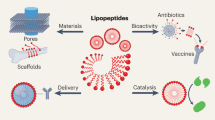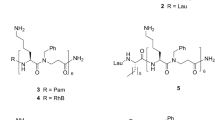Summary
The lipidicα-amino acids (LAAs) are non-naturalα-amino acids with saturated or unsaturated long aliphatic side chains. LAAs and their derivatives (lipid mimetics) together with the lipidic peptides represent a class of compounds which combine structural features of lipids with those of amino acids and peptides. Racemic LAAs may be prepared by classical methods and resolved by chemical or enzymatic methods. LAA amides and esters with saturated or unsaturated long chain amines and alcohols respectively, as well as lipidic dipeptide derivatives inhibit both pancreatic and human platelet phospholipase A2. Lipophilic peptide derivatives are inhibitors of human neutrophil elastase. LAAs and their oligomers have been used as drug delivery system. A Lipid-Core-Peptide system has been designed and used as a combined adjuvant-carrier-vaccine system. A variety of lipid mimetics such as lipidic 2-amino alcohols, lipidic 1,2- and 1,3-diamines have been prepared based upon LAAs. Some of them are potent inhibitors of phospholipase A2. A general approach to enantioselective synthesis of LAAs and lipid mimetics is based on the oxidative cleavage of 3-amino-1,2-diols obtained by the regioselective opening of enantiomerically enriched long chain 2,3-epoxy alcohols.
Similar content being viewed by others
Abbreviations
- Boc:
-
tert-butoxycarbonyl
- BSA:
-
bovine serum albumin
- CD:
-
circular dichroism
- DET:
-
diethyl tartrate
- DIBAL:
-
diisobutyl aluminum hydride
- DMF:
-
N,N-dimethylformammide
- HMPA:
-
hexamethylphosphoramide
- HNE:
-
human neutophil elastase
- LAA:
-
lipidic amino acid
- LAAL:
-
lipidic amino alcohol
- LH-RH:
-
luteinizing hormone-releasing hormone
- LCP:
-
lipid-core-peptide
- LDA:
-
lipidic diamine
- LP:
-
lipidic peptide
- MAP:
-
multiple antigenic peptide
- PLA2 :
-
phospholipase A2
- TBHP:
-
tert-butyl hydroperoxide
- THF:
-
tetrahydrofuran
- TRH:
-
thyrotropin-releasing hormone
- Z:
-
benzyloxycarbonyl
References
Albertson NFJ (1946) The synthesis of amino acids from ethyl acetamidomalonate and ethyl acetamidocyanoacetate. III. The use of primary halides. J Am Chem Soc 68: 450–453
Barrett GC (1985) Chemistry and biochemistry of the amino acids. Chapman and Hall, London
Birnbaum SM, Fu SCJ, Greenstein JP (1953) Resolution of the racemicα-amino derivatives of heptylic, caprylic, nonylic, decylic and undecylic acids. J Biol Chem 203: 333–338
Caron M, Sharpless K (1985) Ti-(O-i-Pr)4 mediated nucleophilic openings of 2,3-epoxy alcohols. A mild procedure for regioselective ring opening. J Org Chem 50: 1557–1560
Caron M, Carlier PR, Sharpless K (1988) Regioselective azide opening of 2,3-epoxy alcohols by [Ti-(O-i-Pr)2(N3)2]: Synthesis ofα-amino acids. J Org Chem 53: 5185–5187
Constantinou-Kokotou V, Kokotos G (1994) Synthesis of 1,3-diamines. Org Prep Proc Int 26: 603–606
Constantinou-Kokotou V, Kokotos G (1995) Conversion of lipidic amino acids into lipidic 1,3-diamines and taurines. Amino Acids 9: 66–67
Christie WW (1982) Lipid analysis, 2nd edn. Pergamon Press, Oxford, p 13
Duthaler R (1994) Recent developments in the stereoselective synthesis ofα-amino acids. Tetrahedron 50: 1539–1650
Fiore S, Nicolaou KC, Caulfield T, Kataoaka H, Serhan C (1990) Evaluation of synthetic sphingosine, lysosphingolipids and glycosphingolipids as inhibitors of functional responces of human neutrophils. Biochem J 266: 25–31
Franson R, Harris L, Ghosh S, Rosenthal M (1992) Sphingolipid metabolism and signal transduction: inhibition ofin vitro phospholipase activity by sphingosine. Biochim Biophys Acta 1136: 169–174
Fukaya N, Ito M, Iwata H, Yamagata T (1989) Characterization of the glycosphingolipids of pig cortical bone and cartilage. Biochim Biophys Acta 1004: 108–116
Gibbons WA (1991) Preparation of racemic and optically -active fatty amino acids, their homo- and hetero-oligomers and conjugates, as pharmaceuticals. Brt Pat Appl GB 2217319 (April 19, 1988). Chem Abstr 114: 235105z
Gibbons WA, Hughes RA, Charalambous M, Christodoulou M, Szeto A, Aulabaugh AE, Mascani P, Toth I (1990) Synthesis, resolution and stuctural elucidation of lipidic amino acids and their homo- and hetero- oligomers. Liebigs Ann Chem: 1175–1183
Greenstein JP, Winitz M (1961) Chemistry of the amino acids. John Wiley and Sons, New York, pp 2381–2406
Hannun Y, Loomis C, Merrill A, Bell R (1986) Sphingosine inhibition of protein kinase C activity and phorbol dibutyrate bindingin vitro and in human platelets. J Biol Chem 261: 12604–12609
Jefferson A, Schulman H (1988) Sphingosine inhibits calmodulin-dependent enzymes. J Biol Chem 263: 15241–15244
Katsuki T, Sharpless KB (1980) The first practical method for asymmetric epoxidation. J Am Chem Soc 102: 5974–5976
Kelly SE (1991) Alkene synthesis. In: Trost BM (ed) Comprehensive oganic synthesis, vol 1. Pergamon Press, Oxford, pp 729–817
Kitamura N, Sagawa K, Takehara M (1987) Cosmetics containingα-amino fatty acids. Kokai Tokkyo Koho Jp Pat 62/4211 (January 10, 1987). Chem Abstr 106: 182464s
Krishnamurthi S, Patel Y, Kakkar V (1989) Week inhibition of protein kinase C coupled with various non-specific effects make sphingosine an unsuitable tool in platelet signal transduction studies. Biochim Biophys Acta 1010: 258–264
Kokotos G (1990) A convenient one-pot conversion of N-protected amino acids and peptides into alcohols. Synthesis: 299–301
Kokotos G, Constantinou-Kokotou V (1992) Modified amino acids and peptides. Part 2. A convenient conversion of amino and peptide alcohols into amines. J Chem Res (S): 391 (M): 3117–3132
Kokotos G, Noula C (1996) A selective one pot conversion of carboxylic acids into alcohols. J Org Chem (accepted)
Kokotos G, Constantinou-Kokotou V, del Olmo Fernandez E, Toth I, Gibbons WA (1992) Conversion of racemic lipidic amino acids into sphingosine and ceramide analogues and 1,2-diamines. Liebigs Ann Chem: 961–964
Kokotos G, Constantinou-Kokotou V, Noula C, Nicolaou A, Gibbons WA (1996a) Synthesis of lipidic amino acid and dipeptide inhibitors of human platelet phospholipase A2. Int J Peptide Protein Res (in press)
Kokotos G, Padron J-M, Noula C, Gibbons W, Martin V (1996b) A general approach to the enantiomeric synhesis of lipidicα-amino acids, peptides and vicinal amino alcohols. Tetrahedron: Asymmetry 7: 857–866
Martin VS, Woodard SS, Katsuki T, Yamada Y, Ikeda M, Sharpless KB (1981) Kinetic resolution of racemic allylic alcohols by enantioselective epoxidation. A route to substances of absolute enantiomeric purity. J Am Chem Soc 103: 6237–6240
Mori K, Funaki Y (1985) Synthesis of (4E,8E,2S,3R,2′R)-N-2′-hydroxyhexadecanoyl-9-methyl-4,8-sphingadienine, the ceramide portion of the fruiting-inducing cerebroside in a basidiomycete Schizophyllum Commune, and its (2R,3S)-isomer. Tetrahedron 41: 2369–2377
Mullmann T, Siegel M, Egan R, Billah M (1991) Sphingosine inhibits phosphatidate phosphohydrolase in human neutrophils by a protein kinase C-independent mechanism. J Biol Chem 266: 2013
Nicolaou A, Kokotos G, Constantinou-Kokotou V, York J, Gibbons WA (1995) Lipidic mimetics as inhibitors of pancreactic phospholipase A2. Biochem Soc Trans 23: 614S
Noula C, Constantinou-Kokotou V, Nicolaou A, Gibbons WA, Kokotos G (1996) Lipid mimetics as inhibitors of human platelet phospholipase A2. Biochem Soc Trans 24: 303S
Roberts DC, Vellaccio F (1983) Unusual amino acids in peptide synhesis. In: Gross E, Meinhofer J (eds) The peptides, analysis, synthesis, biology, vol 5. Academic Press, New York, pp 341–449
Sagawa K, Takehara M (1987a) Polishes. Kokai Tokkyo Koho Jp Pat 62/30171 (February 9, 1987). Chem Abstr 107: 79672e
Sagawa K, Takehara M (1987b) Surface improver for ceramics. Kokai Tokkyo Koho Jp Pat 62/65964 (March 25, 1987). Chem Abstr 107: 63607b
Schollkopf U (1981) Enantioselective synthesis of (R)-amino acids usingL-valine as chiral agent. Angew Chem Int Ed Engl 20: 798–799
Schollkopf U, Neubauer HJ (1982) Asymmetric synthesis via heterocyclic intermediates; XII. Enantioselective synthesis of (R)-α amino acids usingtert-leucine as chiral auxiliary reagent. Synthesis: 61–864
Sweeley CC (1989) Glycosphingolipids: structure and function. Pure Appl Chem: 1307–1312
Takino H, Sagawa K, Kitamura N, Kilahara M (1987) Lubricants containingα-amino fatty acids. Kokai Tokkyo Koho Jp Pat 62/151495 (July 6, 1987). Chem Abstr 107: 220318c
Tam JP (1988) Synthetic peptide vaccine design: synthesis and properties of a highdensity multiple antigenic peptide system. Proc Natl Acad Sci USA 85: 5409–5413
Tam JP (1989) Vaccine engineering: enhancement of immunogenicity of synthetic peptide vaccines related to hepatitis in chemically defined models consisting of T-and B- cell epitopes. Proc Natl Acad Sci USA 86: 9084–9088
Tietze LF, Beifuss U (1991) The Knoevenagel reaction. In: Trost BM (ed) Comprehensive organic synthesis, vol 2. Pergamon Press, Oxford, pp 341–394
Toth I (1994) A novel chemical approach to drug delivery: lipidic amino acid conjugates. J Drug Targeting 2: 217–239
Toth I, Gibbons WA (1992) Surfactants in lipid chemistry: recent synthetic, physical and biodegradative studies. The Royal Society of Chemistry, Cambridge, p 78
Toth I, Gibbons WA (1993) Peptide compounds. Brit Pat Appl GB 92157809 (July 23, 1993).
Toth I, Danton M, Flinn N, Gibbons WA (1993) A combined adjuvant and carrier system for enchancing synthetic peptides immunogenicity utilising lipidic amino acids. Tetrahedron Lett 34: 3925–3928
Toth I, Christodoulou M, Bankowsky, Flinn N, Gibbons WA, Godeau G, Moczar E, Hornebeck W (1995) Design of potent lipophilic-peptide inhibitors of human elastase:in vitro andin vivo studies. Int J Pharm 125: 117–122
Williams RM (1989) Synthesis of optically activeα-amino acids. Pergamon Press, Oxford
Williams RM, Zhai W (1988) Versatile, stereocontrolled, asymmetric synthesis of E-vinyl glycine derivatives. Tetrahedron 44: 5425–5430
Zhai D, Zhai W, Williams R (1988) Alkynylation of mixed acetals with organotin acetylides. J Am Chem Soc 110: 2501–2505
Author information
Authors and Affiliations
Rights and permissions
About this article
Cite this article
Kokotos, G., Martin, V., Constantinou-Kokotou, V. et al. Synthesis of medicinally useful lipidicα-amino acids, 2-amino alcohols and diamines. Amino Acids 11, 329–343 (1996). https://doi.org/10.1007/BF00807940
Received:
Accepted:
Issue Date:
DOI: https://doi.org/10.1007/BF00807940




